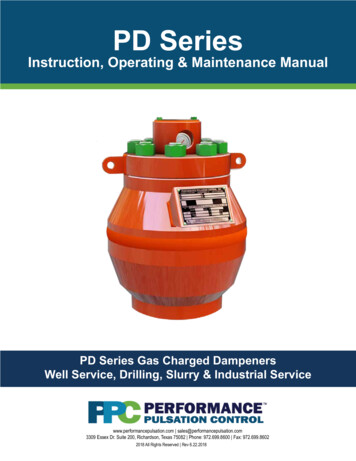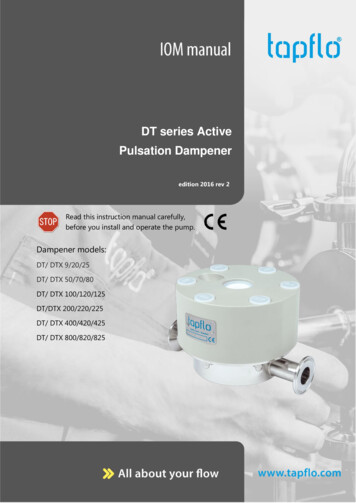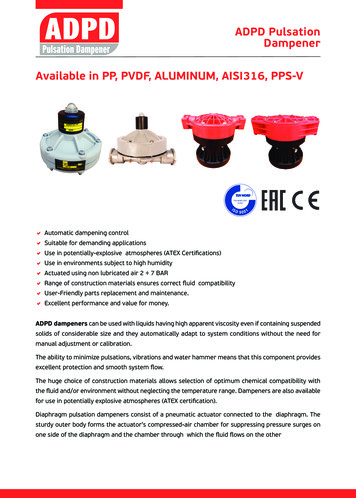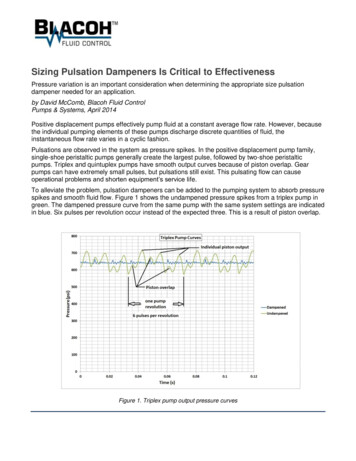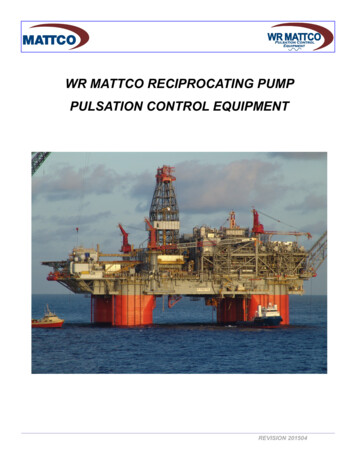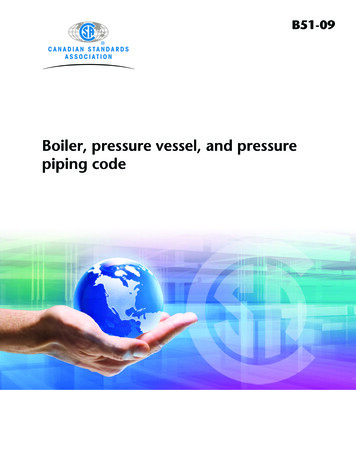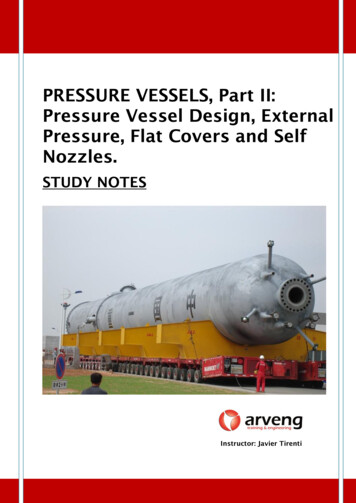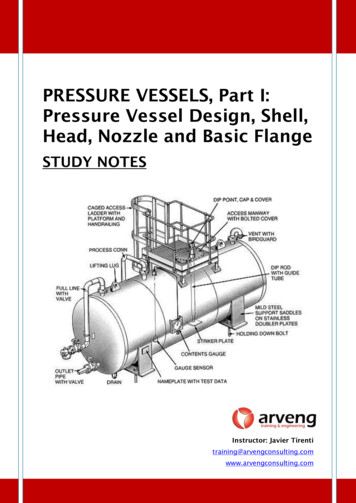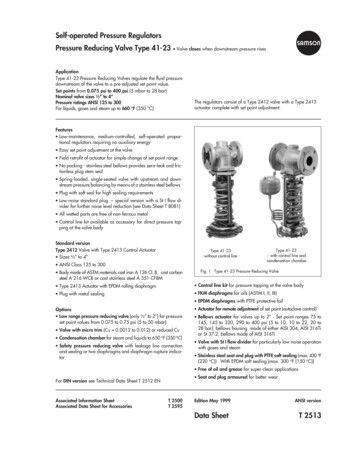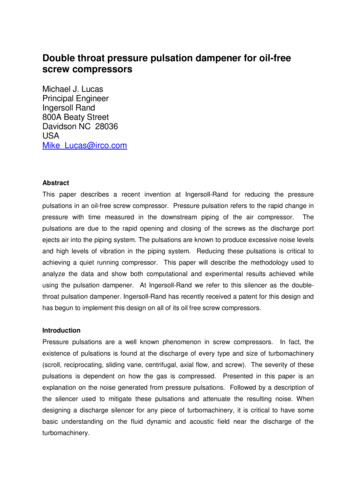
Transcription
Double throat pressure pulsation dampener for oil-freescrew compressorsMichael J. LucasPrincipal EngineerIngersoll Rand800A Beaty StreetDavidson NC 28036USAMike Lucas@irco.comAbstractThis paper describes a recent invention at Ingersoll-Rand for reducing the pressurepulsations in an oil-free screw compressor. Pressure pulsation refers to the rapid change inpressure with time measured in the downstream piping of the air compressor.Thepulsations are due to the rapid opening and closing of the screws as the discharge portejects air into the piping system. The pulsations are known to produce excessive noise levelsand high levels of vibration in the piping system. Reducing these pulsations is critical toachieving a quiet running compressor. This paper will describe the methodology used toanalyze the data and show both computational and experimental results achieved whileusing the pulsation dampener. At Ingersoll-Rand we refer to this silencer as the doublethroat pulsation dampener. Ingersoll-Rand has recently received a patent for this design andhas begun to implement this design on all of its oil free screw compressors.IntroductionPressure pulsations are a well known phenomenon in screw compressors.In fact, theexistence of pulsations is found at the discharge of every type and size of turbomachinery(scroll, reciprocating, sliding vane, centrifugal, axial flow, and screw). The severity of thesepulsations is dependent on how the gas is compressed.Presented in this paper is anexplanation on the noise generated from pressure pulsations. Followed by a description ofthe silencer used to mitigate these pulsations and attenuate the resulting noise. Whendesigning a discharge silencer for any piece of turbomachinery, it is critical to have somebasic understanding on the fluid dynamic and acoustic field near the discharge of theturbomachinery.
Self-Sustained OscillationsSelf-sustained oscillations are characterized by an organized fluid dynamic wave. In thispaper, fluid dynamic or aerodynamic will be used to describe the action of the fluid. In oilfree screw compressors the term fluid implies the compressed air. Self-sustained oscillationscan be decomposed into two components: an acoustic contribution having a wavelength thatis described as λ a that has a speed of sound characterized as c and an aerodynamiccomponent described as λ fluid that has a corresponding velocity u mean . The mean velocityu mean represents the convective velocity of the vortices. Both the aeroacoustic and theaerodynamic fields share the same frequency. When we measure the sound field with amicrophone we are measuring the aeroacoustic sound field that originated from the selfsustained aerodynamic oscillations at the discharge of the compressor.If we were tomeasure the pressure pulsation inside the pipe near the discharge of the compressor wewould measurep( f )Total p( f ) a p ( f ) fluidwhere p( f ) Total is the total pressure field measured by a transducer in the flow. In the nearfield, a majority of total dynamic pressure is generated by forces acting on the gas( p fluid p a ). This effect is often referred to in the literature as the added mass effect (Ref.1). Further downstream from the discharge port of the compressor, the self-sustainedaerodynamic component of the pulsation is expected to diminish because of the formulationof small scale eddy structures typically described as turbulence. It is well known in jet-theorythat these organized structures end several (3 to 5) aerodynamic ( λ fluid ) wavelengthsdownstream from the discharge of the jet. The transition from organized vortex structures tosmall scale turbulent structures denotes the end of the near field. In practice λ fluid is thedistance measured between two successive vortices. The aerodynamic wavelength is easilydetermined by the following equationλ fluid u mean.f
The discharge of a screw compressor port is best described as an impulsively generated jet.An impulsively generated jet can be simulated in a laboratory by the experimental set-upshown in Figure 1. In this arrangement a piston is used to generate a vortex pair by raisingand lowering the arm illustrated in the diagram. This technique can generate remarkablyconsistent vortex pairs. Fundamental studies on the generation and interaction of a vortexpair on a solid body provides a basic understanding on how the flow behaves in the near fieldof the compressor discharge. (Ref. 2)An analytical description of the vortex pair can be found in Batchelor (Ref. 3). Without goinginto the details of this formation, it can be shown that a complete description of the flow is aBessel function of the first order. Figure 2 shows an example of the vortex pair analyticalprediction compared to high speed photography.When the vortex pair is discharged from the compressor port, the vortex pair interacts withany structure that might lie in its path. It is not uncommon for a compressor manufacturer toconnect pipe elbows to the compressor discharge without consideration of the problems theelbow might introduce to the flow. Most elbows will cause some abrupt interaction with thevortex pair, which will lead to a self-sustained oscillation. The fundamental characteristicfeature of a self-sustained interaction is an unstable disturbance (the vortex pair)impingement on a surface that leads to an upstream interaction with the edge of thedischarge port that further amplifies the disturbance. The upstream interaction is an acousticpressure field that occurs practically instantaneous with the surface impingement becausethe pressure field traveling upstream is traveling at the speed of sound (see Figure 1). Theresult is a splintering of the vortex pair into smaller vortices, which are measured acousticallyas harmonics of the port passing frequency (Ref. 4).The fluid dynamic – aeroacousticinteraction just described is the basic principal for the pressure pulsation dampener invention(Ref. 5 and 6).Important Acoustic TermsInsertion Loss (IL) – The difference between the sound power propagating through a ductwith and without the silencer installed.Transmission Loss (TL)– The difference between the sound power level measured at theinlet and outlet of the silencer.
Noise Reduction (NR) – The difference of the sound-pressure level measured near the inletof the muffler and the sound pressure level measured near the discharge.Insertion loss, transmission loss, and noise reduction are three acoustical terms that areeasily confused or misunderstood.They have different physical meanings and uses.Results from noise prediction models are usually presented in the form of transmission loss.Transmission loss characterizes the true performance of a silencer. Transmission loss hasthe advantage of excluding the confusing effects due to acoustic coupling that occursbetween the source, the piping system and the silencer. Insertion loss gives a true measureof a silencer’s performance for a given system. However, the measurements of insertionloss require connecting and disconnecting the silencers from the piping system, which isoften difficult in real applications. Noise reduction measurements are often the measurementof choice given the practicality of performing a single dynamic pressure measurement at theinlet and discharge of the silencer.Important Concepts in Nonlinear AcousticsOne of the concerns with pressure pulsation system inside the piping of a screw compressoris the effect of high-amplitude waves. High-amplitude waveforms caused by the non-linearproperties of the fluid can lead to a steeping of the acoustic waves where the peaks aretravelling faster than the troughs. The distortion in the acoustic wave will lead to additionalharmonics which are often described in terms of a Fourier series.The questioned posed – “Are nonlinear effects important in screw compressors?”In linear acoustic theory, PPeak c 2 ρ ′ where P is the root mean squared pressure, PPeak isthe peak pressure, c is the speed of sound in the media, and ρ ′ is the perturbed density ofthe fluid. In linear acoustic theory it is assumed that the perturbed density of the fluid ismuch less than the density of the fluid ( ρ ′ ρ o ). The sound pressure level is described as PPeak 2SPL 20 log 10 Pref
where Pref 20µPa in air at normal atmospheric conditions. Given that the speed of soundin air is 341 msecdensity ratio (ρ′and the density is 1.2 kgρom3it can be shown that at a SPL of 140 dB the) is equal to 0.002, which is considered the sound pressure levelthreshold in air where nonlinear acoustic effects becomes important.Applying similar theory to screw compressors we will assume that the speed of sound c is420 m sec and the density at 7 bar (100 psig) is 7 kg′kPa (20 psi) then the ratio of ( ρρom3. If the peak-to-peak pressure is 137) is equal to 0.11, which demonstrates that nonlineareffects are important when describing the acoustics inside a screw compressor pipingsystem.Description of InventionThe invention is both an aerodynamic and an aeroacoustic device. An example of the deviceis shown in Figures 3 A & B. The pulsation dampener is made from a single casting toprovide the greatest amount of rigidity to prevent structure borne radiation. The internalconstruction of the device is made of two chambers. The fluid path inside the pulsationdampener is designed to minimize pressure losses by providing smooth transitions betweenthe two chambers, shown in the figures. One of the key features to this device is the jetnozzle formed where the gas enters the first chamber. The existence of the nozzle followedby a sudden expansion formed by the first chamber causes the vortex pair, discharge fromthe compressor, to rapidly breakdown into smaller vortex structures.When the vortexstructures are splintered into smaller structures, the acoustic near field is significantlyshortened in length. The shape of the first chamber serves two purposes. First, the shape ofthe first chamber is designed to minimize the impingement of the vortex structures with wallsor solid surfaces. Second, the shape of the first and second chamber is derived fromanalytical and linear acoustic models to provide the greatest amount of broadbandtransmission loss. Both chambers are acoustically tuned to minimize the transmission ofacoustical waves over a broad range of frequencies from 500 Hz to about 5000 Hz.Today’s silencers used in the compressor industry are either: ¼ wavelength tunedresonators, venturi’s, or absorptive. Rarely these silencers consider the aerodynamics of the
flow; their design is purely acoustical and is based on linear acoustic theory. In actuality theacoustic field in the discharge of the compressor is not linear but rather highly nonlinear.Analytical and numerical tools are unavailable to acousticians to design silencers assumingnonlinear acoustics; as a result, most silencers designed today assume linear acoustictheory as a first order approximation.Figures 4 and 5 show calculated and measured results typical of the pulsation dampener.Figure 4 presents the transmission loss as calculated from commercial acoustical software(SYSNOISE). Figure 5 shows noise reduction loss measured in situ on an actual runningcompressor over a range of drive speeds. Measured and calculated data is presented in bothfigures for version 1 and 2 silencers.ConclusionMeasurement and modelling the fluid flow at the discharge of a screw compressor offersmany challenges. It is difficult to know exactly the true character of the flow given theextreme conditions that exist at the compressor discharge. Only through simplified modelsand basic understanding on the flow mechanics can we begin to estimate the flow character.The double throat pressure pulsation dampener is based on available models, experimentaldata and experience. It is through the combination of these understandings that IngersollRand was successful at developing this device for use in our oil free compressors.References1. Rockwell, D. and Schachmenmann, A.: Self-generation of organized waves in animpinging turbulent jet at low Mach number. J. Fluid Mech. (1982) pp. 425-4392. Homa, J., Lucas, M., and Rockwell, D.: Interaction of impulsively generated vortexpairs with bodies. J. Fluid Mech. (1988), vol. 197, pp. 571-5943. Batchelor, G.K.: An introduction to Fluid Dynamics. Cambridge University Press:19674. Lucas, M. and Rockwell, D.: Self-excited: upstream modulation and multiplefrequencies. J Fluid Mech. (1984), vol. 147, pp. 333-3525. European application was granted February 11, 2009. Patent No. 17152386. US patent issued June 23, 2009, as US Patent No. 7,549,509
AcousticFeedbackPistonInteractionFigure 1. Experimental setup for vortex pair generation and interaction.Figure 2. Vortex pair structural interaction visualization compared to analytical prediction.
Figure 3. Model of a Double Throat pressure pulsation dampener version 1Figure 3 Model of a Double Throat pressure pulsation dampener version 2
Dampener Version 130Transmission Loss, dB25201510500500100015002000Frequency, HzFigure 4A. Transmission loss for the dampener 1.Dampener Version 240Transmission Loss, dB35302520151050050010001500Frequency, HzFigure 4B. Transmission loss for the dampener 2.2000
40Noise Reduction, 20Log10(P1/P2)Inlet and Discharge Pressure Pulsation, psi21 .510 .520004000Frequency, 1/sec201000003060005001000150020002500Frequency, 1/secInlet pressure pulsation shown asred dots. Outlet pressure pulsationshown as black dots.Mesaured noise reduction ratio shownas red dots. Calcuated noise reductionratio shown as black curve.Figure 5A. Double Throat pressure pulsation dampener version 1.40Noise Reduction, 20Log10(P1/P2)Inlet and Discharge Pressure Pulsation, psi020100200040006000Frequency, 1/secInlet pressure pulsation shown asred dots. Outlet pressure pulsationshown as black dots.302010005001000150020002500Frequency, 1/secMesaured noise reduction ratio shownas red dots. Calcuated noise reductionratio shown as black curve.Figure 5B. Double Throat pressure pulsation dampener version 2
using the pulsation dampener. At Ingersoll-Rand we refer to this silencer as the double-throat pulsation dampener. Ingersoll-Rand has recently received a patent for this design and has begun to implement this design on all of its oil free screw compressors. Introduction Pressure pulsations
